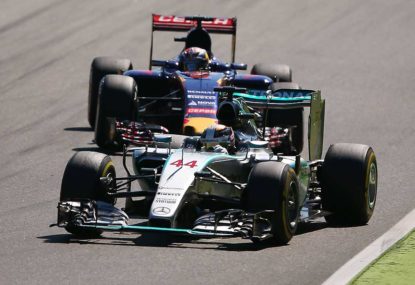'Welcome back': Reliving the last Chinese Grand Prix ahead of its much-anticipated return five years later
Five-years is a long time in motorsport, let alone the general state of the world – especially given the impact of the Covid-19 pandemic…

Six years after he burst into world championship contention with the Red Bull Racing Formula One team in 2009, Mark Webber finally sealed the deal.
The Australian is a champion of the world by way of winning the World Endurance Championship title with Porsche teammates Brendon Hartley and Timo Bernhard.
Despite the Queanbeyan-born (Queanbeyaner? Queanbeyanite? Queanbeyanish?) driver and his contemporaries holding a 12-point lead before the race, they had to fight hard to convert it into a championship after a throttle actuator problem put the #17 Porsche five laps down on the leaders.
The trio could only drag the car back up to fifth, fighting against both traffic and power unit problems, but when the sister Porsche deprived the title-rivals in the #7 Audi of victory, Webber, Hartley, and Bernhard were able to salvage five points and take home the ultimate silverware.
The hard-fought and gritty win underscored by perseverance and will power was in so many ways characteristic of Webber’s career. It’s little wonder his chosen Twitter handle is @AussieGrit.
But by that same token it was a last-round championship duel that demonstrated what the World Endurance Championship is about – bloody hard work. It’s man and machine being pushed to their edge of their performance envelopes. It’s about balancing the risk of new technology against potential performance gains. All of these things featured in Sunday morning’s six hours of Bahrain.
The WEC, as has been written so many time before, is truly coming into its own both on-track and conceptually since its formation in 2012. It knows what it is, and it more or less knows where it’s going.
In stark contrast sits Formula One, basking in the glow of its golden times of yesteryear and with the darkness of uncertainty ahead.
It would be unfair to say that this is because of the nature of the technical regulations alone. They can be easily tweaked to induce any desired effect. The lack of show was unfortunately emphasised by the likes of the WEC and MotoGP themselves enjoying golden spells.
The problem for Formula One is instead existential. What is it? Why does it matter? What piece of the motorsport landscape does it confidently claim as its own?
Formula One was once a leader in prototype cars. The electronic era of the early 1990s, testament to the cutting-edge the sport used to claim, eventually gave way to an impressive but minimally relevant era of aerodynamic development powered by desperately outmoded V8 engines.
In 2014 the sport attempted to refresh itself with the introduction of hybrid turbocharged V6 power units that were all of efficient, interesting, and cutting-edge. Today, little more than two years later, plans are afoot to take a retrograde step on technology by introducing a solely petrol-powered 2.2 litre turbocharged V6. This, by nature, will totally disregard the elements that make the current power plants so impressive – in other words, a meaningless waste.
Elsewhere, debate on the future of the regulations is increasingly centred the speed of the cars. Though still the fastest motorsport category – this year’s Formula One pole lap around Spa-Francorchamps was 7.5 seconds faster than set in the WEC – the 2017 regulations are nonetheless being framed to decrease the average lap time by around five seconds. The caveat is that this seems likely to be done largely through aerodynamics.
While few will argue against faster cars, are faster cars at the expense of closer racing what Formula One wants to hang its hat on? The magic 1000 horsepower figures sounds undoubtedly impressive, but the world’s fastest procession would hardly be the envy of the motorsport community.
Is Formula One home of the world’s best drivers? The current generation of drivers, spanning from Kimi Räikkönen to Max Verstappen, certainly acquit themselves well in this regard.
However, with drivers increasingly interested in trying their luck at Le Mans, this status has been muddied.
This is particularly with 2015’s three highest points-scorers in Lewis Hamilton, Nico Rosberg, and Sebastian Vettel taking it in turns to question the strategy of the sport after an unusually uneventful Brazilian Grand Prix, even this status has become muddied.
“Unfortunately the sport is very political with different interests from different people,” lamented Sebastian Vettel after finishing third in Brazil. “Since the responsible people – the teams, whoever – can’t agree on something, it will be difficult to make progress.”
Even Lewis Hamilton, rarely engaged in Formula One’s politicking, admitted the strategic direction of the sport was controlled by a powerful few.
“At the end of the day it doesn’t really matter what we say,” he added. “The big bosses make the decisions and whether or not they make the right ones for many years, who knows?”
The World Endurance Championship concluded its season with a resounding and confident confirmation that it knows what it is – it sits at the forefront of racing technology, sporting endurance, and contends for the world’s best drivers.
Formula One, will draw 2015 to a close this weekend knowing it has but three precious months to the 2017 regulation deadline to decide what it is – and despite its problems being far from terminal, months of internal wrangling have brought it is no closer to solving its existential crisis.
Follow @MichaelLamonato on Twitter.